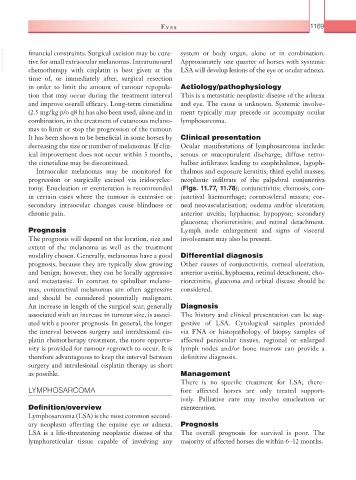Page 1194 - Equine Clinical Medicine, Surgery and Reproduction, 2nd Edition
P. 1194
Eyes 1169
VetBooks.ir financial constraints. Surgical excision may be cura- system or body organ, alone or in combination.
Approximately one quarter of horses with systemic
tive for small extraocular melanomas. Intratumoural
chemotherapy with cisplatin is best given at the
time of, or immediately after, surgical resection LSA will develop lesions of the eye or ocular adnexa.
in order to limit the amount of tumour repopula- Aetiology/pathophysiology
tion that may occur during the treatment interval This is a metastatic neoplastic disease of the adnexa
and improve overall efficacy. Long-term cimetidine and eye. The cause is unknown. Systemic involve-
(2.5 mg/kg p/o q8 h) has also been used, alone and in ment typically may precede or accompany ocular
combination, in the treatment of cutaneous melano- lymphosarcoma.
mas to limit or stop the progression of the tumour.
It has been shown to be beneficial in some horses by Clinical presentation
decreasing the size or number of melanomas. If clin- Ocular manifestations of lymphosarcoma include:
ical improvement does not occur within 3 months, serous or mucopurulent discharge; diffuse retro-
the cimetidine may be discontinued. bulbar infiltrates leading to exophthalmos, lagoph-
Intraocular melanomas may be monitored for thalmos and exposure keratitis; third eyelid masses;
progression or surgically excised via iridocyclec- neoplastic infiltrate of the palpebral conjunctiva
tomy. Enucleation or exenteration is recommended (Figs. 11.77, 11.78); conjunctivitis; chemosis; con-
in certain cases where the tumour is extensive or junctival haemorrhage; corneoscleral masses; cor-
secondary intraocular changes cause blindness or neal neovascularisation; oedema and/or ulceration;
chronic pain. anterior uveitis; hyphaema; hypopyon; secondary
glaucoma; chorioretinitis; and retinal detachment.
Prognosis Lymph node enlargement and signs of visceral
The prognosis will depend on the location, size and involvement may also be present.
extent of the melanoma as well as the treatment
modality chosen. Generally, melanomas have a good Differential diagnosis
prognosis, because they are typically slow growing Other causes of conjunctivitis, corneal ulceration,
and benign; however, they can be locally aggressive anterior uveitis, hyphaema, retinal detachment, cho-
and metastasise. In contrast to epibulbar melano- rioretinitis, glaucoma and orbital disease should be
mas, conjunctival melanomas are often aggressive considered.
and should be considered potentially malignant.
An increase in length of the surgical scar, generally Diagnosis
associated with an increase in tumour size, is associ- The history and clinical presentation can be sug-
ated with a poorer prognosis. In general, the longer gestive of LSA. Cytological samples provided
the interval between surgery and intralesional cis- via FNA or histopathology of biopsy samples of
platin chemotherapy treatment, the more opportu- affected periocular tissues, regional or enlarged
nity is provided for tumour regrowth to occur. It is lymph nodes and/or bone marrow can provide a
therefore advantageous to keep the interval between definitive diagnosis.
surgery and intralesional cisplatin therapy as short
as possible. Management
There is no specific treatment for LSA, there-
LYMPHOSARCOMA fore affected horses are only treated support-
ively. Palliative care may involve enucleation or
Definition/overview exenteration.
Lymphosarcoma (LSA) is the most common second-
ary neoplasm affecting the equine eye or adnexa. Prognosis
LSA is a life-threatening neoplastic disease of the The overall prognosis for survival is poor. The
lymphoreticular tissue capable of involving any majority of affected horses die within 6–12 months.

